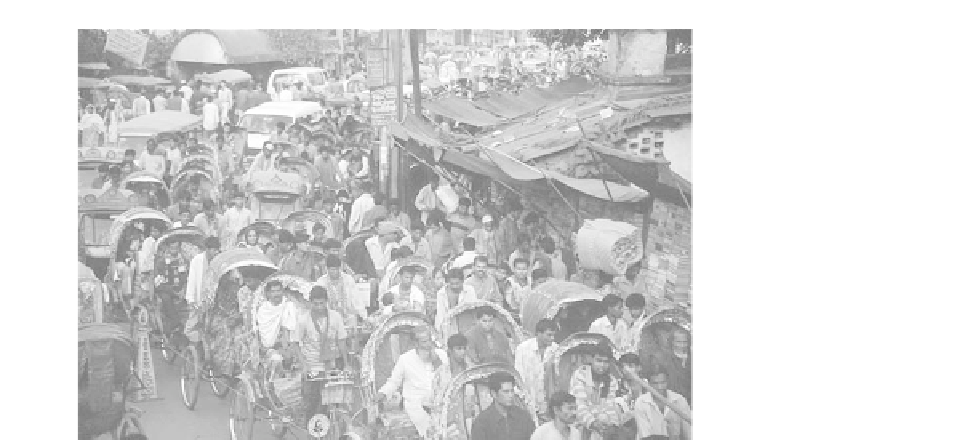Geography Reference
In-Depth Information
Figure 9-8
T Traffic crush in Dhaka. In all my travels, I have
never seen anything to equal the traffic jams in
Bangladesh.
Photograph courtesy of B. A. Weightman.
In the 1960s, industries were given incentives to
locate outside Dhaka. However, they located just beyond
an established boundary to claim “less-developed area”
status and still enjoy the advantages of urban location.
These and other efforts at decentralization were disrupted
by the 1971 war of independence.
In the 1980s, subdistricts called
upazilas
were created
in Bangladesh. Each of these 500 subdistricts was to
house an average of 186,000 people and have revenue-
raising powers and measures of self-government. How-
ever, related employment development has not slowed
out-migration.
Although foreign investment and new construction
are changing Dhaka' s skyline, labor strikes called
hartals
are frequent, and infrastructural problems remain over-
whelming. Power outages are daily events. Inadequate
garbage and sewage removal results in clogged canals
and drainage backups and overflow . Raw sewage gushes
into the Bay of Bengal. Vehicles belch diesel fumes, and
industries pour raw effluents into canals and poisonous
chemicals into the air. Dhaka is now one of the most
polluted cities in the world. Lead poisoning is more
than double unsafe levels. Thousands of premature
deaths and millions of cases of illness result from the
city' s pollution.
There are more than 175,000 motor vehicles in
Dhaka, including more than 40,000 auto rickshaws that
use a deadly combination of engine oil and leaded gas.
Beginning in 1999, the government took steps to reduce
lead pollution by banning the import of leaded fuels and
calling for catalytic converters on new cars. Auto rick-
shaws were to be phased out. However, these are mostly
still plans. Population and urban growth, natural calami-
ties, and political or other instabilities or inefficiencies
can easily slow or halt implementation.
AQUA-BUSINESS AND THE TEXTILE INDUSTRY
Bangladesh' is frozen food industry is founded on fish,
prawns, and similar products. More than 11 million indi-
viduals, mostly women, are connected either directly or
indirectly with the fisheries sector for their livelihood.
Oceans, rivers, lakes, canals, and more than a million
human-made ponds and tanks are fishery sources.
Shrimp exporting began in the early 1970s, earning
US$3 million. By 1996-1997 this had increased to
US$279 million. Increasing numbers of fish farms and
hatcheries along with offshore cage fishing have made
this into a US$500 million industry . Chittagong and
Mangla are the most important processing centers, and
aqua-business is now second to textiles in terms of foreign
exchange earnings.
The textile industry is the most important sector of
Bangladesh' s economy , accounting for nearly 80 percent
of the country' s exports. Garment exports to rich coun-
tries accounted for US$8.9 billion in 2005. Competi-
tion from China has not hurt the industry because
Bangladeh still has the lowest wages in the global textile
sector.
Bangladesh is most competitive in knitwear, which
makes up half of the garments manufactured. This is
because three-quarters of inputs are made locally . This
saves the firms storage and transport costs, import
duties, and long lead-times that come with imported

















Search WWH ::

Custom Search